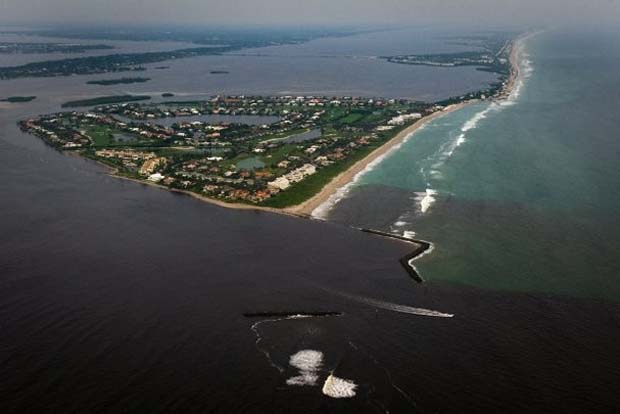 STUART, Florida, August 21, 2013
STUART, Florida, August 21, 2013
[dropcap]Y[/dropcap]esterday, the Florida Department of Environmental Protection hosted a public meeting before roughly 60 attendees to begin planning for the next round of projects and activities to restore the St. Lucie River and Estuary. The meeting continues the commitment of the Department and stakeholders to solve water quality problems in the basin.
“Just last month we were here to celebrate adoption of the first phase of a long-term plan to restore the St. Lucie River and Estuary,” said Tom Frick, Program Administrator for the Water Quality Restoration Program within DEP’s Division of Environmental Assessment and Restoration. “Recent algal blooms only reinforce the importance of the work ahead and the need to take advantage of the existing momentum and energy at the local level.”
In 2009, the Department adopted water quality restoration targets, called Total Maximum Daily Loads, to address nutrient (nitrogen and phosphorus) pollution in the river and estuary. Based on comprehensive monitoring and analysis during phase I of the Basin Management Action Plan, the Department determined that reductions in nitrogen concentrations ranging from 21.4 to 51.8 percent and phosphorus concentration reductions ranging from 41.3 to 78.6 percent are needed to meet water quality standards, depending on the waterbody segment.
These reduction goals are the basis for the Department’s restoration plan. The first phase identified the pollutant reduction responsibilities of basin stakeholders, the projects and activities they will implement in the next five years as well as monitoring plans to track changes in water quality.
During this first phase, and accounting for local investments made in advance of formal adoption, 51 percent of the nitrogen and more than 37 percent of the phosphorus reductions will be achieved. More than 537,000 pounds per year of nitrogen loadings and 151,000 pounds per year of phosphorus loadings will be eliminated from the St. Lucie River and Estuary Basin. Local governments have already invested nearly $230 million on projects in the basin since 2000 to address stormwater runoff in particular. Additional information about investments in the region can be found here.
Wednesday’s meeting kicked off planning for the second five years of restoration plan progress. Stakeholders discussed the overall schedule, focusing on time frames for new project identification, design and coordination. The Department will work closely with stakeholders to prioritize the areas that would benefit most from new stormwater projects. Additional water quality monitoring and modeling options for the St. Lucie restoration plan study area were also discussed.
As the longer term St. Lucie restoration plan projects are implemented, and in response to the recent algal blooms, the Department, Fish and Wildlife Conservation Commission, Department of Health and South Florida Water Management District are working together to address more immediate public health concerns in the interconnected St. Lucie River, Indian River Lagoon and Lake Okeechobee systems. More information about those efforts can be found here.
The Department and water management district, in particular, are coordinating on comprehensive long-term water quality improvement and water management strategies for these waterbodies. The agencies, along with other state and local partners, are investing hundreds of millions of dollars to balance flood control, navigation, water supply, water quality and overall ecological health.







